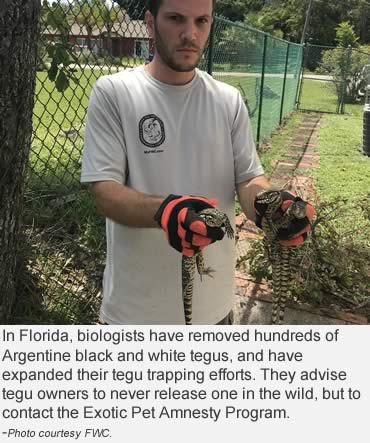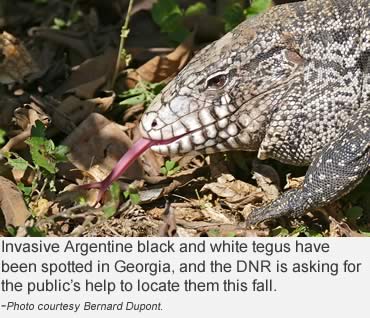It’s big. Not gigantic, but big. About 4 1/2-feet long, if it’s an adult.
It’s invasive. And that’s the really scary part.
Some people keep them as pets. But when they escape or grow so large that the pet owner can’t handle it, sometimes the pet owner (foolishly) releases it into the wild. Or, it may have grown so large it escaped from its cage.
In Georgia and Florida, they’re spotted on game cameras. Sometimes they’re found as roadkill.
In every single instance, there are people in a state Department of Natural Resources or Fish and Game who want to know where it was seen, so it can be removed or trapped before it further endangers native wildlife.
What is it?
It’s an Argentine black and white tegu.
The new invasive bad guy is native to Brazil, Paraguay, Uruguay and northern Argentina in South America. It’s a lizard that grows up to 4 1/2-feet feet long and 15 pounds as an adult. Worse, it’s hungry and very skilled at finding eggs from ground-nesting birds like quail and turkeys, American alligators, turtles, and even domestic chicken eggs.
 These voracious, omnivorous predatory lizards also consume insects, snails, plants, fruits, and pet food left outside, everything from rats and skinks to blackberries and beetles.
These voracious, omnivorous predatory lizards also consume insects, snails, plants, fruits, and pet food left outside, everything from rats and skinks to blackberries and beetles.
Tegus do not pose a threat to humans. They’re not venomous, they don’t run fast, but they’re armed with strong jaws and tails they can wield as thumping weapons.
The presence of tegus is similar to any nonnative invasive species detrimental to native wildlife and natural habitats, and “can pose a risk to human health and safety,” according to Kristen Sommers of the Florida Fish and Wildlife Impact Management System.
In Florida, the Argentine black and white tegu is considered a high priority invasive species like pythons and lionfish. In fact, tegus can invade any area with a similar climate.
Another consideration once a nonnative species becomes established, is the amount of time and funds needed to control the species as its number increases.
Stopping the influx of tegus before they become firmly established is the goal in Georgia where the Department of Natural Resources and Georgia Southern University scientists are asking residents to be on the lookout for the invasive tegu lizards.
They are especially interested in reports from eastern Toombs and western Tattnall counties.
With help provided by scientists at the US Geological Survey, the DNR and Georgia Southern University Biology Department, biologists, faculty and students are on the hunt and are trapping tegu lizards this fall.
They hope to better understand the abundance and distribution of the lizards in the area, as well as prevent their spread, and they are timing it before the lizard takes a nap for winter.
 Observant residents can report sightings and assist trapping efforts before tegus enter brumation, a hibernation-like state cold-blooded animals enter during cold weather.
Observant residents can report sightings and assist trapping efforts before tegus enter brumation, a hibernation-like state cold-blooded animals enter during cold weather.
Georgia wildlife laws allow for tegus to be trapped or killed in a humane fashion in accordance with local ordinances. As a nonnative species, they are not protected by Georgia’s wildlife laws or regulations.
In Florida, a number of tegus are removed annually by the Florida Fish and Wildlife Conservation Commission, the University of Florida and partners within the Everglades Cooperative Species Management Area.
Additionally, private trappers remove tegus.
To Report a Tegu in Georgia Call the DNR at (478) 994-1438, or note the location, date and time the tegu was spotted on this website: www.gainvasives.org/tegus. If possible, take a photo and email it to gainvasives@dnr.ga.gov.
To Report a Tegu in Florida Call the Exotic Specials Hotline (888) 483-4681. Pet owners can turn in tegus to the Exotic Pet Amnesty Program by calling (888) 483-4681.
Resources: Georgia Department of Natural Resources, Florida Fish and Wildlife Conservation Commission, United States Geological Survey, United States Fish and Wildlife Service.